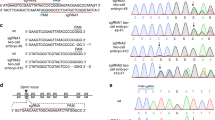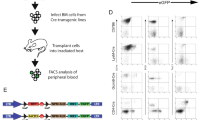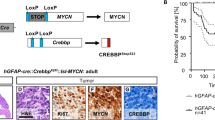Abstract
THE int-1 proto-oncogene was first identified as a gene activated in virally induced mouse mammary tumours1,2. Expression studies, however, suggest that the normal function of this gene may be in spermatogenesis and in the development of the central nervous system3–5. Genes sharing sequence similarity with int-1 have been found throughout the animal kingdom. For example, int-1 has 54% amino-acid identity to the Drosophila segment polarity gene wingless (wg)6. Both the int-1 and wg gene products seem to be secreted proteins, presumably involved in cell–cell signalling7–11. We have now explored the function of int–1 in the mouse by disrupting one of the two int-1 alleles in mouse embryo-derived stem cells using positive–negative selection12. This cell line was used to generate a chimaeric mouse that transmitted the mutant allele to its progeny13–16. Mice heterozygous for the int-1 null mutation are normal and fertile, whereas mice homozygous for the mutation may exhibit a range of phenotypes from death before birth to survival with severe ataxia. The latter pathology in mice and humans is often associated with defects in the cerebellum. Examination of int-l–/int-l– mice at several stages of embryo-genesis revealed severe abnormalities in the development of the mesencephalon and metencephalon indicating a prominent role for the int-1 protein is in the induction of the mesencephalon and cerebellum.
This is a preview of subscription content, access via your institution
Access options
Subscribe to this journal
Receive 51 print issues and online access
$199.00 per year
only $3.90 per issue
Buy this article
- Purchase on Springer Link
- Instant access to full article PDF
Prices may be subject to local taxes which are calculated during checkout
Similar content being viewed by others
References
Nusse, R. & Varmus, H. E. Cell 31, 99–109 (1982).
van Ooyen, A. & Nusse, R. Cell 39, 233–240 (1984).
Jakobovits, A., Shackleford, G. M., Varmus, H. E. & Martin, G. R. Proc. natn. Acad. Sci. U.S.A. 83, 7806–7810 (1986).
Shackleford, G. M. & Varmus, H. E. Cell 50, 89–95 (1987).
Wilkinson, D. G., Bailes, J. A. & McMahon, A. P. Cell 50, 79–88 (1987).
Rijsewijk, F. et al. Cell 50, 649–657 (1987).
Morata, G. & Lawrence, P. A. Devl Biol. 56, 227–240 (1977).
Baker, N. E. EMBO J. 6, 1765–1770 (1987).
Papkoff, J., Brown, A. M. C. & Varmus, H. E. Molec. cell. Biol. 7, 3978–3984 (1987).
Bradley, R. S. & Brown, A. M. EMBO J. 9, 1569–1575 (1990).
Papkoff, J. & Schryver, B. Molec. cell. Biol. 10, 2723–2730 (1990).
Mansour, S. L., Thomas, K. R. & Capecchi, M. R. Nature 336, 348–352 (1988).
Bradley, A., Evans, M., Kaufman, M. H. & Robertson, E. Nature 309, 255–256 (1984).
Capecchi, M. R. Trends Genet. 5, 70–76 (1989).
Capecchi, M. R. Science 244, 1288–1292 (1989).
Rossant, J. & Joyner, A. Trends Genet. 5, 277–283 (1989).
Thomas, K. R. & Capecchi, M. R. Cell 51, 503–512 (1987).
Doetschman, T., Maeda, N. & Smithies, O. Proc. natn. Acad. Sci. U.S.A. 85, 8583–8587 (1988).
Zimmer, A. & Gruss, P. Nature 338, 150–153 (1989).
Joyner, A. L., Skarnes, W. C. & Rossant, J. Nature 338, 153–156 (1989).
Johnson, R. S. et al. Science 245, 1234–1236 (1989).
Koller, B. H. & Smithies, O. Proc. natn. Acad. Sci. U.S.A. 86, 8932–8935 (1989).
Mansour, S. L., Thomas, K. R., Deng, C. & Capecchi, M. R. Proc. natn. Acad. Sci. U.S.A. (in the press).
Zijlstra, M., Li, E., Sajjadi, F., Subramani, S. & Jaenisch, R. Nature 342, 435–438 (1989).
Schwartzberg, P. L., Goff, S. P. & Robertson, E. J. Science 246, 799–803 (1989).
Zijlstra, M. et al. Nature 344, 742–746 (1990).
DeChiara, T. M., Efstratiadis, A. & Robertson, E. J. Nature 345, 78–80 (1990).
Koller, B. H., Marrack, P., Kappler, J. W. & Smithies, O. Science 248, 1227–1230 (1990).
Fell, H. P., Yarnold, S., Hellstrom, I., Hellstrom, K. E. & Folger, K. R. Proc. natn. Acad. Sci. U.S.A. 86, 8507–8511 (1989).
Schwartzberg, P. L., Robertson, E. J. & Goff, S. P. Proc. natn. Acad. Sci. U.S.A. 87, 3210–3214 (1990).
Hallonet, M. R., Teillet, M. & LeDouarin, N. M. Development 108, 19–31 (1990).
Author information
Authors and Affiliations
Rights and permissions
About this article
Cite this article
Thomas, K., Capecchi, M. Targeted disruption of the murine int-1 proto-oncogene resulting in severe abnormalities in midbrain and cerebellar development. Nature 346, 847–850 (1990). https://doi.org/10.1038/346847a0
Received:
Accepted:
Issue Date:
DOI: https://doi.org/10.1038/346847a0
Comments
By submitting a comment you agree to abide by our Terms and Community Guidelines. If you find something abusive or that does not comply with our terms or guidelines please flag it as inappropriate.



